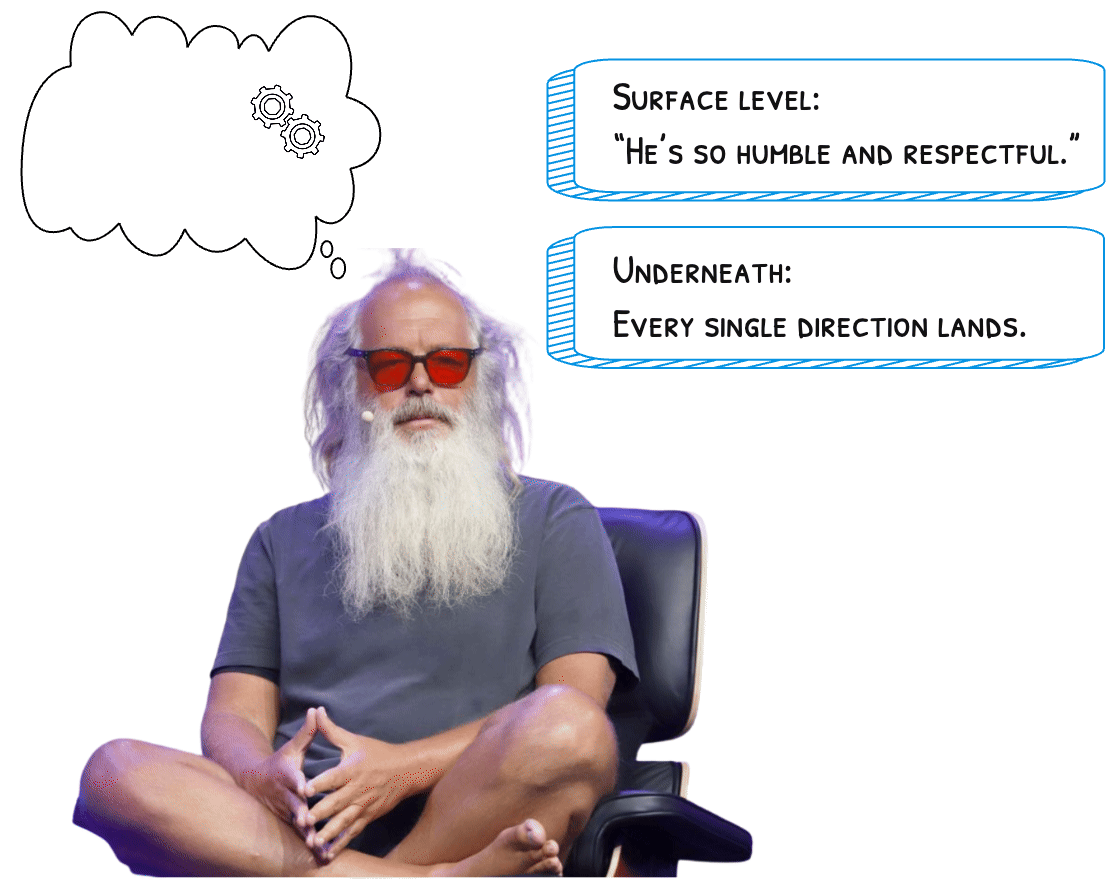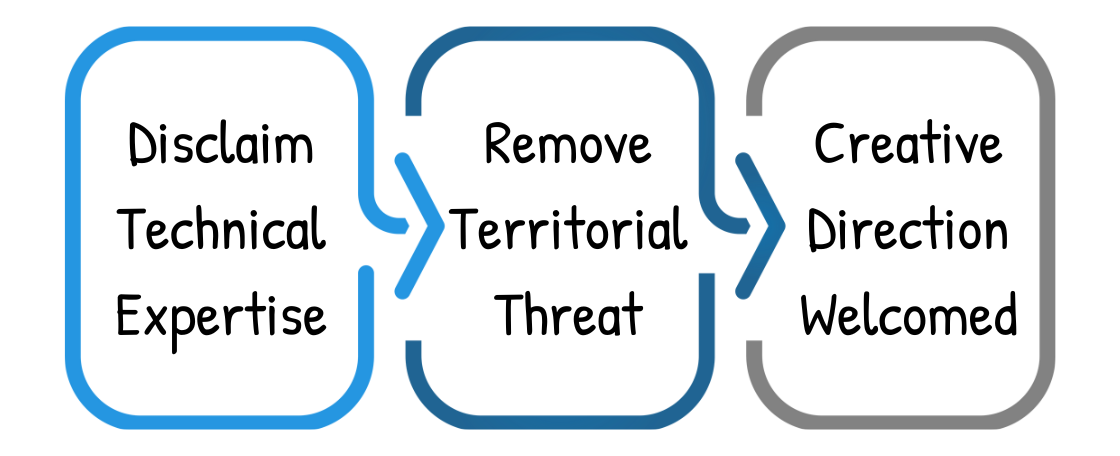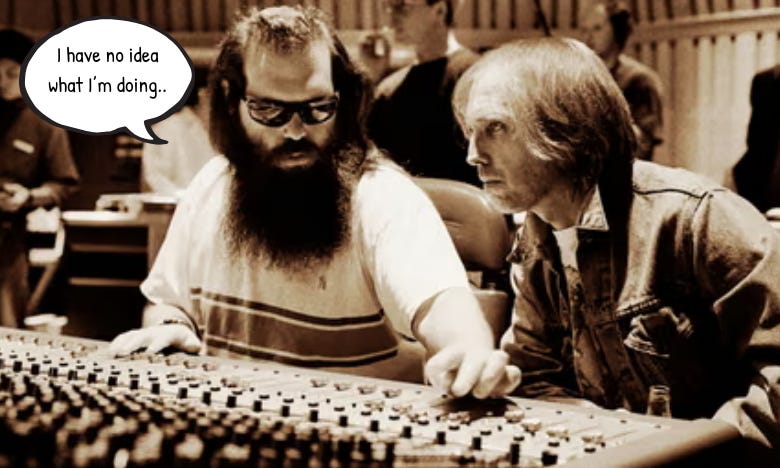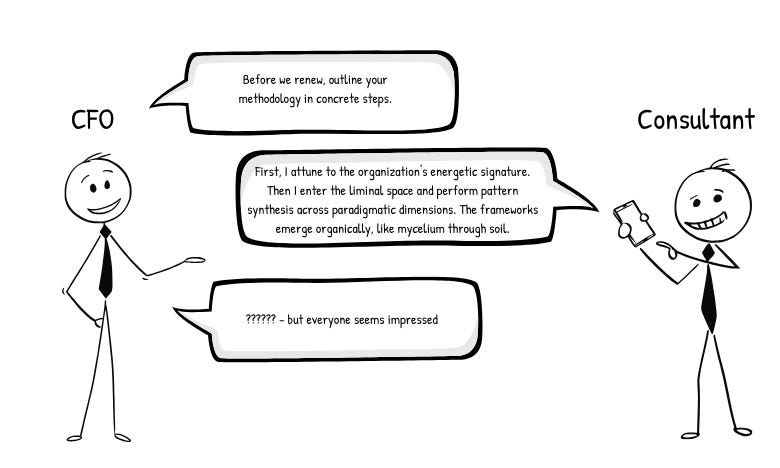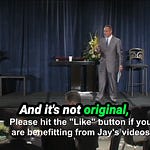Rick Rubin has produced more platinum albums than almost anyone alive. Red Hot Chili Peppers. Johnny Cash. Beastie Boys. Kanye West. Adele. System of a Down. The list reads like a museum of iconic sound.
Yet in every interview, he says the same thing: “I’m not a musician.”
To Rick Beato, he gets even more specific:
“If we went to a studio I could not run a session myself. I couldn’t record it. I can’t do their job. I can’t sub for them. I can’t get by. I cannot do those jobs.”
The man who tells engineers where to place the microphone claims he doesn’t know how microphones work. The producer who greenlit Johnny Cash’s American Recordings by saying ‘record everything raw’ insists he can’t run a session.
And everyone believes him. Musicians, engineers, interviewers.
Watch any interview. You’ll never notice what’s happening. You think you’re learning about his production philosophy. But there’s a second conversation running underneath. While you’re tracking his words, his disclaimers are rewiring your defenses.
Rubin doesn’t eliminate his authority. He weaponizes his lack of it.
Every “I’m not,” every “I can’t,” every disclaimer operates as precision engineering. Listen to any thirty-minute conversation. Count the disclaimers. The pattern is unmistakable.
You’ve fallen for it every time you’ve watched him. Andrew Huberman walked away satisfied without getting concrete answers. Rick Beato challenged the contradictions and still accepted them. Understanding these patterns transforms you from viewer to player. Once you see them, you can use them.
After reading this, you’ll see it everywhere. Even knowing about it won’t stop it from working.
Pattern #1: The Authority Inversion
Position Below, Lead From There
Here’s what Rick does unconsciously:
He disclaims expertise (genuinely) then directs everything from that lower position.
Watch it happen:
Beato, himself a producer with forty years in studios, asks about Rick’s technical knowledge. Rick’s response arrives without hesitation:
“I don’t know anything about equipment. I don’t. I don’t. If we went to a studio I could not run a session myself. I couldn’t record it. I can’t do their job. I can’t sub for them. I can’t get by. I cannot do those jobs.”
Count the repetitions. “I don’t. I don’t.” “I can’t. I can’t. I cannot.” That’s belief hammering itself into your brain.
While literally running every session.
Making every creative decision.
Directing engineers on exactly what to capture.
About musicianship, talking about the Chili Peppers:
“That’s why I say I’m not a musician. There’s some of the best musicians in the world. Chad, Flea and John, those three musicians. I don’t know that you can find better musicians than those three musicians.”
He elevates them to “best musicians in the world” while positioning himself outside the category.
Then he tells them what to play.
When Rick says “I can’t run a session,” the threat disappears. You’re not being lectured by an authority. You’re hearing from someone who respects your domain.
So when his creative direction comes, you’re receptive to it.
The humility removes the barrier. His creative vision lands because there’s no ego collision.
The Power of this Pattern
This unconscious pattern operates completely outside his awareness.
Rick thinks he can’t do what engineers do. He’s right. He can’t operate the gear at their level. But what he CAN do is hear what’s working and what isn’t. He makes the creative decisions that matter.
He’s positioned himself below on technical skill while operating above on creative vision. The disclaimer removes the threat. So when Rick says “I’m hearing something in that take” or “could we try this differently?” the engineer thinks “let me help this guy get what he needs” instead of “this producer is stepping on my toes.”
The humility makes you want to collaborate. That’s how he gets exactly what he’s hearing without triggering resistance.
Influence through collaboration, not compliance through hierarchy.
How to spot it:
Watch for: “I’m not...” “I can’t...” “I don’t know...” followed by expert-level execution
Count: Disclaimers per conversation (Rick averages one every 3-4 minutes)
Notice: He never circles back to claim competence. Stays in the lower position permanently.
Use this yourself:
When influencing peers or managing up:
“I don’t have the technical depth you do, but what I’m noticing in the data is...”
“I can’t run SQL queries like your team can, but here’s what stands out in these results...”
The Formula:
“I can’t do X” (removes the threat) + While doing X (collaborative direction) = You stay open + His creative vision lands
You’ve just learned one of five patterns Rick runs simultaneously. At the end of this article, I’ll show you how to extract YOUR version of these patterns: the ones you’re already using unconsciously that make people lean in when you talk.
The Supporting Patterns
The Authority Inversion is just the beginning. Rick runs four other patterns simultaneously, each reinforcing the others.
Pattern #2: The Paradox He Can’t See
Generate contradictions without recognizing them
The contradiction in “I don’t know equipment” gets even stranger.
Beato pushes back: “But you know what the gear is. You know the difference between a Neve and an API.”
Rick responds: “I do because I’ve been in places with both of them yes. But it doesn’t matter.”
He just contradicted himself. Admitted he DOES know the gear. Then pivoted to “it doesn’t matter” instead of resolving the paradox.
Your brain does something fascinating here. It makes him MORE sophisticated, not less credible.
You think: “He knows but the knowledge isn’t about technical specs. There’s something deeper happening.”
Unresolved paradox signals depth.
“I don’t know equipment” + demonstrates equipment knowledge = your brain thinks “they’re operating beyond my level” instead of “they’re contradicting themselves.”
This protects Rick’s methodology. He can’t be pinned down to simple explanations. The both/and thinking reads as sophistication, not confusion.
What Rick gains:
Maintains mystique. Avoids being reduced to concrete methodology. The paradox becomes proof of sophistication rather than inconsistency.
How to spot it:
Listen for: Two opposing statements in same conversation
Watch for: No acknowledgment of the contradiction. He pivots instead of resolving.
Notice: When “but” or “though” should appear to reconcile, but doesn’t
Use this yourself:
When positioning unique value that doesn’t fit traditional boxes:
“I don’t write code, but I’ve architected systems used by millions of users”
“I’m not a designer, but the interfaces I spec consistently convert at 40%”
Don’t resolve the paradox. Let them hold both truths. The contradiction reads as nuance, not inconsistency. It signals you’re operating in a space that transcends the either/or framework they’re trying to use.
Pattern #3: The Dream State Deflection
Replace concrete method with poetic abstraction
Huberman asks him directly: “How do you access creativity?”
Rick’s answer:
“I think the best way to think about it is like a dream. It’s like, if you think about your dreams, they don’t necessarily make sense. When you wake up, you might remember part but not the whole thing... we’re making things, and we’re looking for feeling in ourselves.”
Huberman, a neuroscientist trained to extract mechanisms, walks away satisfied.
Rick gave him a metaphor, not a method. Zero actionable steps. Pure abstraction.
Your brain processes metaphor as wisdom. The poetic language triggers a “profound insight” response. You fill in the blanks with your own meaning. You feel understood without being constrained by actual methodology.
And here’s what Rick gains: He can’t be proven wrong. Can’t be reduced to a checklist. Can’t have his process commoditized.
The metaphor lets everyone project their own understanding onto it. A songwriter hears “follow feeling” and applies it to lyrics. A designer hears it and applies it to visual composition. The abstraction works for everyone because it’s specific to no one.
What Rick protects: His actual unconscious process. If he gave you five concrete steps, you could follow them and potentially get the same results. The dream metaphor preserves the mystery. You leave feeling like you learned something while his actual methodology remains completely intact.
How to spot it:
Listen for: “It’s like a dream...” “Think of it as...” “The best way to describe it is...”
Count: Metaphors vs. concrete steps (Rick gives 5-10 metaphors per interview, zero step-by-step processes)
Notice: You walk away feeling enlightened without gaining actionable methodology
Use this yourself:
When asked to explain expertise you can’t (or won’t) articulate in steps:
Client: “What’s your process for finding product-market fit?”
You: “Think of it like tuning an instrument. You’re listening for resonance between what you’re saying and what they’re hearing. Sometimes you can feel the disconnect before you can explain why—the messaging is technically correct but something’s slightly off. You adjust based on that feedback, sensing when you’ve hit the right frequency. It’s less about following steps and more about developing an ear for when it clicks.”
Formula:
Replace “Here are the 5 steps” with “It’s like [evocative metaphor]... you’re sensing [feeling-based language].”
They create their own meaning, feel satisfied, and your actual process stays protected. They can’t commoditize what you won’t specify.
Later, I’ll give you the exact AI prompts that extract these patterns from YOUR conversations: the specific phrases you use that make clients trust you without knowing why.
Pattern #4: The Question Transplant
Answer the question you wish they’d asked
Beato asks: “When did you know that you had this gift for being a music producer?”
Rick answers: “I didn’t. I never knew that. I first connected with music, I want to say it was about 3 years old...”
He answered “when did you connect with music” instead of “when did you know you had producing gift.”
The redirect happens in the same territory. Your brain gets AN answer. Doesn’t notice it wasn’t THE answer. Satisfaction comes from receiving something substantive, not from precision.
Here’s what Rick avoids:
Questions he can’t or won’t answer. The original question implies self-awareness about his gifts. But Rick genuinely doesn’t think in those terms. He can’t answer “when did you know” because he never did know.
So he redirects to what he CAN answer authentically: his love of music. Same general territory (music origins), but a question he has an answer for. You get a real story. He stays in his comfort zone. Everyone walks away satisfied.
What Rick gains:
Controls the narrative without seeming evasive. Appears to answer while avoiding questions that would expose gaps in self-knowledge or methodology. The redirect keeps him in territory where he’s genuinely comfortable and authentic.
How to spot it:
Track: Write down the question asked, then compare to what actually got answered
Listen for: “What I’ve found is...” “The way I think about it...” (redirect signals)
Test: Can you quote the original question after his answer? (Usually no. You forgot within 30 seconds.)
Use this yourself:
When asked something you can’t or won’t answer directly:
Client: “What’s your pricing model?”
You: “What I’ve found is most clients care less about the model than about ROI. Here’s how we think about value creation...”
Or when question has a false premise:
“Why is your process slower than competitors?”
You: “The interesting thing is speed and quality aren’t in tension. What we’ve found is...”
The Question Transplant Formula:
Reframe Signal + Challenge Premise/Redirect Focus + Answer Better Question
Reframe Signals:
“What I’ve found is...”
“The interesting thing is...”
“Here’s what matters more...”
“The real question is...”
Structure:
Don’t answer their question
Signal the redirect (”What I’ve found is...”)
Reframe the premise (pricing → ROI, speed → quality)
Answer the question you want (value creation, not pricing model)
Acknowledge the territory. Answer the better question. They walk away satisfied without you addressing the problematic framing. You stay in control while appearing cooperative.
Pattern #5: The Praise Deflection Reflex
Cannot hold compliments. Instant redirect to others.
Beato: “That is an amazing song” (referring to Blood Sugar Sex Magic)
Rick, instantly: “You have to also keep in mind. They’re really a good band... That’s why I say I’m not a musician. There’s some of the best musicians in the world.”
The compliment enters. Before Beato’s sentence ends, Rick redirects it. Under two seconds from praise received to credit deflected.
Notice what just happened: Rick used Pattern #1 (Authority Inversion) inside Pattern #5. “I’m not a musician” removes his authority while deflecting praise.
The patterns stack. The disclaimer makes the deflection more powerful. He’s not just being humble, he’s positioning himself below them.
This makes him humble. Makes the musicians feel seen. Builds fierce loyalty.
Your brain expects ego, gets generosity. Trust increases exponentially.
What Rick gains:
The musicians feel valued. When you consistently deflect praise to collaborators, they want to work with you again. They bring their best because they know you’ll honor their contribution. The deflection isn’t just modesty. The pattern builds relationship architecture that makes people loyal.
How to spot it:
Count: Seconds between compliment and deflection (Rick’s is instant, usually under 2 seconds)
Watch for: “You have to understand...” “Keep in mind...” “It’s really...” (deflection openers)
Notice: He never circles back to accept even partial credit. Stays in deflection mode permanently.
Use this yourself:
When receiving praise for collaborative work:
Client: “This design is beautiful!”
You: “You have to understand, Sarah’s eye for color theory is what made this work. I just structured the layout. She brought it to life with that palette.”
Formula:
Accept compliment → Immediately spotlight collaborator’s specific contribution → Stay there
Result:
Team loyalty deepens + you’re seen as generous leader + people want to work with you because you make them feel valued.
Once You See Rick’s Patterns, You Spot Them Everywhere
Brian Eno: “I’m not really a musician in the traditional sense...” Authority Inversion.
Quincy Jones: “I don’t know how to explain what I do...” Dream State Deflection.
Daniel Lanois credits the artists: “They’re the ones who bring the magic...” Praise Deflection Reflex.
Same patterns. Different producers. One playbook.
They learned something traditional producers haven’t. In creative work, claiming authority triggers resistance. Disclaiming it creates space for influence.
The old playbook was confidence and expertise displayed. The new playbook is influence from the lower position.
But Enough About Rick Rubin
He’s already produced more iconic albums than most people could list in an hour.
The real discovery isn’t his patterns.
What you’re already running. Equally powerful patterns of your own. You just can’t see them because they’re YOUR defaults. What’s invisible to Rick is visible to us. What’s invisible to you is visible to others.
What’s invisible to you?
Maybe you naturally:
Remove threat through strategic disclaimers before directing
Use productive paradoxes that signal depth rather than confusion
Deploy abstraction to protect methodology while appearing generous
Redirect questions to territory where you’re genuinely strong
Deflect praise in ways that build fierce team loyalty
You’ve been using these your whole life. You just never named them.
The techniques you use unconsciously that make clients lean in when you talk. The patterns that close deals without feeling salesy. The moves you can’t see because they’re as natural as breathing.
What’s Below the Paywall
Your Invisible Patterns:
3 AI Prompts That Extract Your Unconscious Influence Patterns
The 5-Signal System for Spotting These Patterns in Real-Time Conversations
Word-for-Word Scripts: How to Use Authority Inversion Without Losing Credibility
The Reverse Rubin Protocol: How to Get Concrete Answers from Abstract Communicators
The Paradox Framework: When Contradiction Signals Sophistication vs. Confusion
Pattern Library: 47 Additional Influence Patterns Across 12 Domains
Understanding Rick Rubin is just the beginning. The real power comes from discovering patterns you’re already using unconsciously.
The ones that make people trust you without knowing why. That close opportunities without triggering resistance. That create collaboration instead of compliance. That you can’t see because they’re as invisible to you as Rick’s patterns are to him.
For less than you spent on lunch today, discover the psychological patterns you’re already running unconsciously.
Listen to this episode with a 7-day free trial
Subscribe to Signal>Noise to listen to this post and get 7 days of free access to the full post archives.


